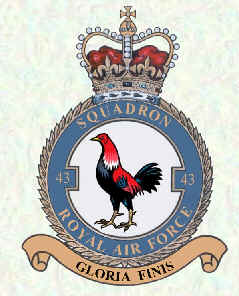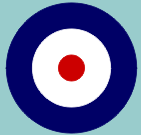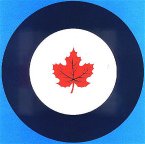No 43
(China-British) Squadron
Ref: www.rafweb.org
 'The
Fighting Cocks' were formed on 15 April 1916 at Stirling equipped with
various types, which it used for training until December 1916 when Sopwith
1½ Strutters arrived. These were taken to the Western Front the
following month, where it operated as an Army squadron carrying out fighter
reconnaissance duties. In September 1917, Camels arrived and ground
attack replaced the reconnaissance duties and the squadron continued in
the vain until the end of the war. Snipe began to be received
in August 1918 and conversion was completed in October but the Armistice
prevented these playing a major part in the conflict, instead they were
taken to Germany for occupation duties until August 1919 when the squadron
moved to Spittlegate where it disbanded on 31 December 1919.
'The
Fighting Cocks' were formed on 15 April 1916 at Stirling equipped with
various types, which it used for training until December 1916 when Sopwith
1½ Strutters arrived. These were taken to the Western Front the
following month, where it operated as an Army squadron carrying out fighter
reconnaissance duties. In September 1917, Camels arrived and ground
attack replaced the reconnaissance duties and the squadron continued in
the vain until the end of the war. Snipe began to be received
in August 1918 and conversion was completed in October but the Armistice
prevented these playing a major part in the conflict, instead they were
taken to Germany for occupation duties until August 1919 when the squadron
moved to Spittlegate where it disbanded on 31 December 1919.
The squadron reformed on 1 July 1923 at Henlow, again
it was a fighter squadron and initially it was equipped with its previous
mount the Snipe. However, Gamecocks were received in March 1926 and
conversion was complete by May. It was this aircraft which led the
squadron to adopt the 'fighting cock' as its emblem resulting in its famous
'nickname'. The squadron moved to Tangmere in December 1926 where
Siskins replaced the Gamecocks in June 1928. These in their turn
were replaced by Furies in May 1931 and hurricanes in Nov 1938.
A move north in late 1939 lasted until May 1940 when the
squadron returned to Tangmere and later Northolt, where it took part in
the early part of the Battle of Britain. A move to Usworth in September
and them Drem in December allowed the squadron to re-equip and act in a
training role as well as carry out defensive duties. In June 1942
it returned to Tangmere and offensive operations over France, but the centre
of operations was shifting and in September the squadron prepared to move
to the Middle East.
It arrived in Gibraltar in November and was soon operating
from bases in Algeria, where in February 1943 it converted to Spitfires.
From June it covered the landings in Sicily from its new base on Malta
after which it moved to newly captured airfields on Sicily itself.
Its next move was to Italy in September providing fighter patrols for the
advancing armies. For six weeks from July 1944 it was based in Corsica
to cover the Allied landings in Southern France, 'Operation Dragoon', after
which it returned to Italy, where it remained for the remainder of WW2.
Occupation duties in Austria and Italy lasted until the squadron disbanded
on 16 May 1947 at Treviso.
A new 43 Squadron appeared on 1 February 1949 when No
266 Squadron was renumbered. It once again found itself at its 'traditional'
home of Tangmere, but this was short-lived as the squadron was moved north
to Leuchars in Scotland in November 1950. Initially equipped with
Meteors, Hunters arrived in August 1954. After nearly eleven years
at Leuchars the squadron moved to Cyprus in June 1961 and Aden in March
1963, where it disbanded on 14 October 1967. During the period 13
Mar 1951 to 31 May 1956, the squadron was linked to No 17 in order to keep
that squadron's number active.
However, it was not long before 43 returned and a new
squadron was formed at Leuchars on 1 September 1969. It was still
in the fighter role but was now equipped with the Phantom FG Mk 1, which
it continued to operate until Jul 1989. It also used some FGR Mk
2s from May 1988 to November 1988. In July 1989 the squadron's last
Phantom was retired and the squadron began training on the Tornado F Mk
2, its first aircraft being received in September when the squadron became
operational again. It continues to fly these in the air defence role
from its base at Leuchars.
Motto: Gloria Finis (Glory is the end)
Copyright © M B Barrass 2001- 2006




![]()
![]()
![]()
![]()